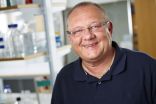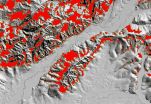(Press-News.org) A physicist in Syracuse University's College of Arts and Sciences is the lead contributor to the discovery of two never-before-seen baryonic particles. The finding, which is the subject of a forthcoming article in Physical Review Letters (American Physical Society, 2014), is expected to have a major impact on the study of quark dynamics.
Steven Blusk, associate professor of physics, has identified particles known as Xi_b'- and Xi_b*-. Although the particles had been predicted to exist, nobody has seen them until now. The discovery is part of his ongoing work at the Large Hadron Collider beauty (LHCb) experiment at CERN in Geneva, Switzerland.
"The particles we've discovered are quite unique," says Blusk, a leader in experimental high-energy particle physics. "Each one contains a beauty [b] quark, a strange [s] quark, and a down [d] quark."
A baryon is a subatomic particle made up of three quarks, bound together by strong force. Two other familiar baryons, the proton and neutron, combine with the electron to form all the known elements of the Periodic Table.
"The building blocks of all known things, including cars, planets, stars, and people, are quarks and electrons, which are tied together by strong, electromagnetic forces," Blusk says.
Unique to each newly discovered particle is its mass, which is approximately six times larger than that of the proton. Blusk attributes its size to the presence of a heavyweight b quark and to the particle's angular momentum--a property known as "spin."
In the Xi_b'- state, the spins of the two lighter quarks point in opposite directions; in the Xi_b*- state, they are aligned. The difference is what makes the Xi_b*- a little heavier.
"The Xi_b'- is close in mass to the sum of the masses of its decay products. If it had been just a little lighter, we wouldn't have seen it at all," Blusk adds.
Much of Blusk's work draws on the theory of Quantum Chromodynamics, which describes the interaction of quarks. As a result, he and his colleagues have studied the masses of both particles, along with their relative production rates, widths, and decays.
"This is a very exciting result," Blusk adds. "Thanks to LHCb's excellent hadron identification, which is unique among LHC experiments, we've been able to separate a clean, strong signal from the background. It demonstrates, once again, both the sensitivity and precision of the LHCb detector."
Blusk is part of a team of Syracuse researchers, led by Distinguished Professor of Physics Sheldon Stone, working at CERN, which is the world's leading laboratory for particle physics. There, they have been involved with the LHCb experiment, which seeks to identify new forces and particles, in addition to those already known and codified in the Standard Model, a theory describing the physical makeup of the visible Universe.
"Fourteen billion years ago, the Universe began with a bang, and matter and anti-matter were formed," Stone says. "But just one second after the Big Bang, anti-matter all but disappeared. ...The LHCb experiment is designed to find out what really happened after the Big Bang that has allowed matter to survive and build the Universe we inhabit today."
Housed in The College, the Department of Physics has been educating students and carrying out research for more than 125 years. Graduate and undergraduate opportunities are available in fields ranging from biological and condensed matter physics, to cosmology and particle physics, to gravitational wave detection and astrophysics.
INFORMATION:
The first issue of a new publication series from The Gerontological Society of America (GSA) called From Policy to Practice explores pain as a public health problem and takes a look at how various policies impact the care provided to patients in a range of practice settings. It also provides readers with an overview of provisions of the Affordable Care Act that address pain research, education, training, and clinical care -- as well as steps taken to implement those provisions.
"An Interdisciplinary Look at the Potential of Policy to Improve the Health of an Aging America: ...
Physician-researchers from the Cardiac Center at The Children's Hospital of Philadelphia (CHOP) presented new findings on pediatric cardiovascular disease at the American Heart Association's Scientific Sessions 2014 in Chicago. Among many other topics, they investigated using automated external defibrillators in infants, long-term cardiac risk in surgical survivors of the Fontan operations for congenital heart disease, and whether centers that perform more cardiac catheterizations tend to have better outcomes.
Pediatric cardiologist Yoav Dori, M.D., Ph.D., delivered ...
Alexandria, Va., USA - Today, the International and American Associations for Dental Research (IADR/AADR) published a special themed issue of the Journal of Dental Research (JDR) centered on novel dental biomaterials and technologies. Although the Associations have published clinical supplements to the JDR, this is the first special themed issue the Associations have published.
This special themed issue of the JDR contains a collection of timely articles designed to provide the reader with a review of some of the important new material developments, as well as examples ...
Peruvian coastal waters may provide suitable habitat that may help the recovery of endangered South Pacific green turtles, according to a study published November 19, 2014 in the open-access journal PLOS ONE by Ximena Velez-Zuazo from University of Puerto Rico and colleagues.
Green turtles inhabit tropical and subtropical coastal waters around the world. The authors of this study worked to identify suitable habitat for the endangered species by measuring two populations off the Peruvian coast from 2010 to 2013 in potentially important feeding grounds.
The researchers ...
Florida harvester ants move and construct a similar subterranean nest about once a year, according to a study published November 19, 2014 in the open-access journal PLOS ONE by Walter Tschinkel from Florida State University.
The Florida harvester ant excavates up to 2 meter deep nests in the sandy soils of the Gulf and Atlantic coastal plains. Scientists tracked and mapped nest relocations of over 400 colonies in a north Florida coastal plains pine forest from 2010 to 2013 and monitored the progress of entire relocations of 20 of these nests.
The researchers found that ...
A new study in mice, conducted by researchers at Sweden's Karolinska Institutet together with colleagues in Singapore and the United States, shows that our natural gut-residing microbes can influence the integrity of the blood-brain barrier, which protects the brain from harmful substances in the blood. According to the authors, the findings provide experimental evidence that our indigenous microbes contribute to the mechanism that closes the blood-brain barrier before birth. The results also support previous observations that gut microbiota can impact brain development ...
LA JOLLA--Scientists at the Salk Institute have discovered a powerful one-two punch for countering a common genetic mutation that often leads to drug-resistant cancers. The dual-drug therapy--with analogs already in use for other diseases--doubled the survival rate of mice with lung cancer and halted cancer in pancreatic cells.
Lung cancer, which affects nonsmokers as well as smokers, is the most common cancer worldwide, causing 1.6 million deaths a year, far more than pancreatic, breast and colon cancer combined. About 30 percent of the most common type of lung cancer ...
WASHINGTON, D.C. - An antidepressant commonly prescribed for women with postpartum depression may restore connections between cells in brain regions that are negatively affected by chronic stress during pregnancy, new research suggests.
Ohio State University scientists found that rats that had been chronically stressed during pregnancy showed depressive-like behaviors after giving birth, and structures in certain areas of their brains were less complex than in unstressed rats. After receiving the drug for three weeks, these rats had no depressive symptoms and neurons ...
New York City residents' movement around the city was perturbed, but resumed less than 24-hours after Hurricane Sandy, according to a study published November 19, 2014 in the open-access journal PLOS ONE by Qi Wang and John Taylor from Virginia Tech.
Tropical cyclones, including hurricanes and typhoons, are severe natural disasters that can cause tremendous loss of human life and suffering. Our knowledge of peoples' movements during natural disasters is so far limited due to a lack of data. The authors of this article studied human mobility using movement data from individuals ...
CORVALLIS, Ore. - Engineers have created a new way to use lidar technology to identify and classify landslides on a landscape scale, which may revolutionize the understanding of landslides in the U.S. and reveal them to be far more common and hazardous than often understood.
The new, non-subjective technology, created by researchers at Oregon State University and George Mason University, can analyze and classify the landslide risk in an area of 50 or more square miles in about 30 minutes - a task that previously might have taken an expert several weeks to months. It can ...





